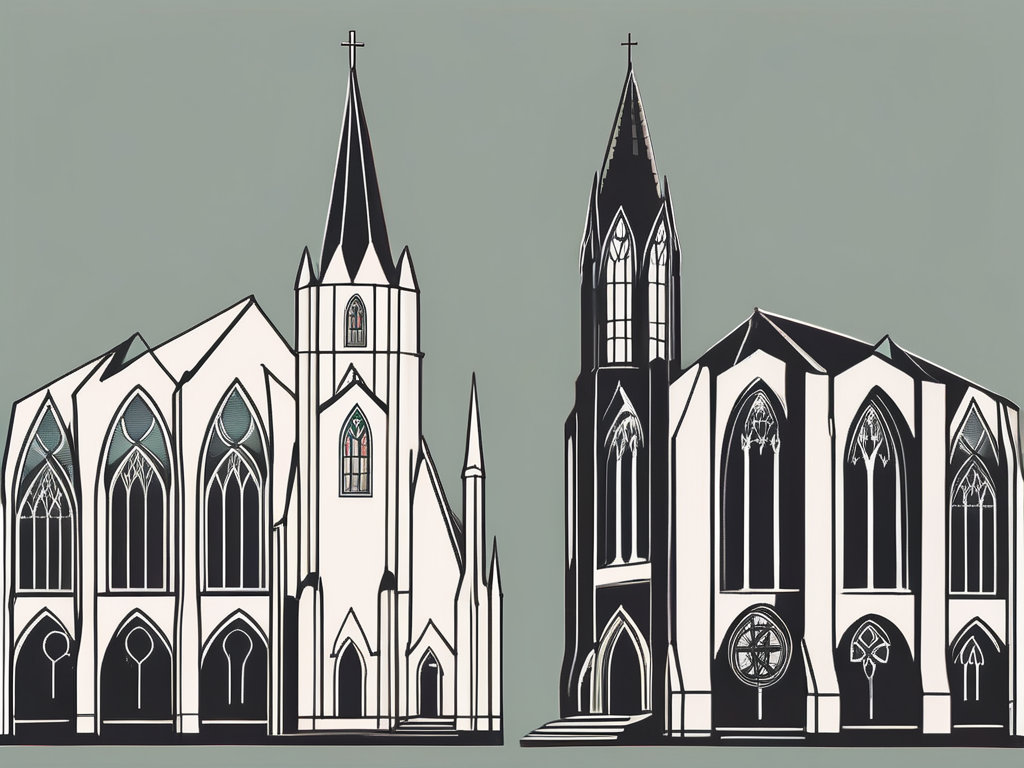If you’ve ever wondered about the differences and similarities between Anglicanism and Protestantism, you’re not alone. These two branches of Christianity have distinct histories, beliefs, and practices that set them apart from each other. In this article, we will explore the historical background, core beliefs and practices, theological differences and similarities, worship styles and liturgy, as well as church governance and structure of Anglicanism and Protestantism.
Historical Background of Anglicanism and Protestantism
Before diving into the specifics, it’s essential to understand the origins and development of both Anglicanism and Protestantism.
Anglicanism traces its roots back to the English Reformation during the 16th century. It emerged as a distinct branch of Christianity when King Henry VIII broke away from the authority of the Roman Catholic Church and established the Church of England. This decision was primarily motivated by Henry VIII’s desire for an annulment of his marriage to Catherine of Aragon, which the Pope refused to grant. Thus, Henry VIII took matters into his own hands and declared himself the Supreme Head of the Church of England.
Throughout its history, Anglicanism has been influenced by both Catholic and Protestant traditions, which has contributed to its unique character. The early Anglican Church retained many Catholic practices, such as the use of liturgy, sacraments, and hierarchical structure. However, it also embraced Protestant principles, such as the emphasis on Scripture as the ultimate authority and the rejection of certain Catholic doctrines, such as the veneration of saints and the authority of the Pope.
Origin and Development of Anglicanism
The English Reformation, which gave birth to Anglicanism, was a complex and multifaceted process. It was not solely driven by religious factors but also by political, social, and economic considerations. The Reformation in England was marked by a series of legislative acts and religious debates that shaped the development of the Anglican Church.
One significant figure in the early history of Anglicanism is Archbishop Thomas Cranmer. Cranmer played a crucial role in shaping the theological and liturgical foundations of the Church of England. He was responsible for the creation of the Book of Common Prayer, a comprehensive liturgical guide that became the standard for Anglican worship. The Book of Common Prayer blended elements of Catholic tradition with Protestant theology, reflecting the unique character of Anglicanism.
Birth and Growth of Protestantism
Protestantism, on the other hand, stems from the broader movement known as the Protestant Reformation. Led by Martin Luther in the early 16th century, Protestantism sought to reform certain practices and teachings of the Catholic Church. Luther’s Ninety-Five Theses, which he famously nailed to the door of the Castle Church in Wittenberg, Germany, questioned the sale of indulgences and challenged the authority of the Pope.
Luther’s ideas spread rapidly across Europe, sparking a wave of religious and social change. The Protestant Reformation led to the establishment of various Protestant denominations, each with its own distinct beliefs and practices. These included Lutheranism, Calvinism, and Anabaptism, among others. Each denomination had its own theological nuances and interpretations of Scripture, contributing to the diversity within Protestantism.
Over time, Protestantism continued to evolve and diversify. The movement gave rise to influential theologians and leaders, such as John Calvin, who developed the system of Reformed theology, and John Wesley, who founded the Methodist movement. Protestantism also played a significant role in shaping the political and social landscape of Europe, with the rise of Protestant nations and the impact of Protestant ideas on governance and individual rights.
In conclusion, the historical background of Anglicanism and Protestantism is a rich tapestry of events, personalities, and theological debates. From the English Reformation to the broader Protestant Reformation, these movements have left an indelible mark on the religious and cultural landscape of the world. Understanding their origins and development is crucial to appreciating the complexities and nuances of these branches of Christianity.
Core Beliefs and Practices
When it comes to core beliefs and practices, both Anglicanism and Protestantism have their own distinct emphases. However, delving deeper into these traditions reveals a rich tapestry of beliefs and practices that have shaped the lives of millions of people throughout history.
Anglicanism, as a branch of Christianity, upholds the belief in the Holy Trinity, the divinity of Jesus Christ, and the authority of Scripture. These fundamental beliefs provide a strong foundation for Anglican theology and worship. Central to Anglican worship is the Book of Common Prayer, which contains liturgical prayers and rituals. This book serves as a guide for Anglicans, helping them navigate through the various seasons of the liturgical year and providing a framework for communal worship.
Within Anglicanism, there is also a recognition of the seven sacraments, including baptism and the Eucharist. These sacraments hold a significant place in the spiritual life of Anglicans, serving as visible signs of God’s grace and presence. Through baptism, individuals are initiated into the Christian community, while the Eucharist, also known as Holy Communion or the Lord’s Supper, is a symbolic reenactment of Jesus’ Last Supper with his disciples.
On the other hand, Protestantism, as a diverse movement within Christianity, places a strong emphasis on the authority of Scripture as the sole source of religious truth. This principle, known as sola scriptura, is central to Protestant theology and distinguishes it from other Christian traditions. While Protestant denominations may vary in their interpretations of specific doctrines, they generally emphasize salvation by faith alone and the priesthood of all believers.
Salvation by faith alone, also known as sola fide, is a key principle of Protestantism. It asserts that individuals are justified before God by faith in Jesus Christ, rather than by their own good works or merits. This belief highlights the importance of a personal relationship with God and the transformative power of faith.
Furthermore, the concept of the priesthood of all believers is another significant aspect of Protestantism. It emphasizes the idea that all believers have direct access to God and can serve as ministers of the Gospel. This principle challenges the hierarchical structure of traditional religious institutions and encourages active participation and engagement from every member of the faith community.
Many Protestant churches conduct worship services with a focus on preaching and congregational singing. The sermon, delivered by a pastor or minister, plays a central role in these services, providing spiritual guidance, teaching, and encouragement to the congregation. Congregational singing, often accompanied by musical instruments, allows worshippers to express their devotion and unite their voices in praise.
In conclusion, while Anglicanism and Protestantism share some common beliefs and practices, they also have their own distinct emphases. Anglicanism finds its identity in the Holy Trinity, the divinity of Jesus Christ, and the authority of Scripture, while Protestantism places a strong emphasis on the authority of Scripture, salvation by faith alone, and the priesthood of all believers. These core beliefs and practices have shaped the lives of millions of individuals, providing them with a framework for worship, spiritual growth, and community engagement.
Theological Differences and Similarities
When exploring the theological landscape of Christianity, it is fascinating to examine the similarities and differences between Anglicanism and Protestantism. While these two branches of Christianity share some theological commonalities, they also diverge in significant ways.
One of the fundamental areas where Anglicanism and Protestantism exhibit contrasting beliefs is their understanding of salvation. Anglicanism embraces a balanced view, affirming that salvation is a combination of God’s grace and human response through faith and good works. In this perspective, salvation is not solely dependent on faith but also encompasses the active participation of individuals in doing good works as a response to God’s grace.
On the other hand, many Protestant denominations emphasize salvation by faith alone. They emphasize that salvation is a gift from God, received solely through faith in Jesus Christ. Good works, according to this perspective, are seen as a natural outpouring of faith rather than a means of obtaining salvation.
Another area of divergence between Anglicanism and Protestantism lies in their perspectives on sacraments. Anglicanism recognizes and practices sacraments as visible signs of God’s grace, believing that they are a means of experiencing God’s presence in a tangible way. The Anglican tradition upholds the belief that sacraments, such as baptism and the Eucharist, are not merely symbolic but are efficacious channels of divine grace.
Protestants, on the other hand, may have a more symbolic or simplified understanding of sacraments. While they acknowledge the significance of sacraments, they tend to focus more on their symbolic nature rather than their efficacy as channels of divine grace. For Protestants, sacraments serve as powerful reminders of God’s love and grace, but they do not believe that the sacraments themselves convey grace in a supernatural manner.
Exploring the theological differences and similarities between Anglicanism and Protestantism provides a rich tapestry of perspectives within the Christian faith. These variations in beliefs highlight the diversity and complexity of Christianity, inviting individuals to engage in thoughtful dialogue and deepen their understanding of the divine.
Worship Styles and Liturgy
When it comes to worship styles and liturgy, Anglicanism and Protestantism have notable distinctions.
Anglican worship is characterized by its rich liturgical traditions, incorporating formal prayers, readings from the Bible, and the singing of hymns. The Eucharist, also known as Holy Communion or the Lord’s Supper, holds a central place in Anglican worship. The use of liturgical vestments and the use of incense may also be present in some Anglican services.
Within the Anglican tradition, there are different styles of worship that reflect the diversity within the Anglican Communion. High church Anglicans tend to have a more formal and elaborate liturgy, with a greater emphasis on ritual and ceremony. This style of worship often includes the use of incense, bells, and choral music. On the other hand, low church Anglicans have a more simplified and informal style of worship, focusing more on the spoken word and congregational participation.
In addition to the Eucharist, Anglican worship services may also include other sacraments such as baptism and confirmation. These sacraments are seen as important milestones in the spiritual journey of an individual and are often celebrated within the context of a worship service.
Protestant worship services, on the other hand, vary widely depending on the denomination. Some Protestant churches opt for a more casual and contemporary style of worship, featuring contemporary music and spontaneous prayers. These services often take place in modern church buildings, with a band leading the congregation in worship songs. The atmosphere is often relaxed and informal, with an emphasis on creating a welcoming and inclusive environment.
Other Protestant churches may have a more structured format, similar to Anglican liturgy, incorporating hymns, Bible readings, and prayers. These services often take place in more traditional church buildings, with a focus on reverence and solemnity. The use of liturgical elements such as vestments and candles may also be present in these services.
It is important to note that while there are these general trends in worship styles and liturgy within Anglicanism and Protestantism, there is also a great deal of diversity within each tradition. Different churches and denominations may have their own unique worship practices and liturgical traditions, influenced by factors such as culture, history, and theological beliefs.
Church Governance and Structure
Church governance and structure play a vital role in shaping the identity and functioning of religious communities. When comparing Anglicanism and Protestantism, it becomes evident that they differ significantly in their approaches to church organization.
Anglican Church Hierarchy
Anglicanism, with its roots in the Church of England, has a hierarchical structure that emphasizes the authority of the Archbishop of Canterbury. As the spiritual leader of the Anglican Communion, the Archbishop holds a position of great influence and responsibility. The Church of England itself is further organized into dioceses, each headed by a bishop.
Bishops, within the Anglican tradition, play a significant role in the governance and decision-making processes. They are responsible for overseeing the spiritual well-being of their respective dioceses and ensuring the adherence to Anglican teachings and practices. Bishops are also involved in the appointment and supervision of clergy, as well as the resolution of conflicts within the church.
Furthermore, the Anglican Church places importance on the concept of apostolic succession, which asserts that the authority and lineage of bishops can be traced back to the apostles. This belief reinforces the hierarchical structure and the authority vested in the bishops.
Protestant Church Leadership
Protestant denominations, on the other hand, often have a more decentralized structure. They tend to prioritize the autonomy and participation of individual congregations in decision-making processes. This approach reflects the Protestant emphasis on the priesthood of all believers, which asserts that every Christian has direct access to God and can interpret scripture independently.
Within Protestantism, church leadership can take various forms. Some denominations are governed by elected boards or committees comprised of both clergy and laity. These bodies are responsible for making important decisions and overseeing the affairs of the church. Other Protestant churches may adopt a congregational model, where decisions are made collectively by the members of the congregation. In such cases, the pastor or minister often serves as a facilitator or advisor rather than an authoritative figure.
Protestant churches value the active involvement of their members in the decision-making process, as it reflects their belief in the priesthood of all believers. This participatory approach allows for a greater sense of ownership and engagement within the congregation.
It is worth noting that while Anglicanism and Protestantism differ in their approaches to church governance, both traditions strive to uphold the teachings of Christ and serve their respective communities. The differences in structure reflect the diverse theological perspectives and historical contexts from which these traditions emerged.
In conclusion, the differences in church governance and structure between Anglicanism and Protestantism are significant. Anglicanism embraces a hierarchical structure with the Archbishop of Canterbury at the helm, while Protestant denominations often adopt a more decentralized approach that values congregational participation. Understanding these differences enhances our appreciation for the rich tapestry of Christian traditions and the various ways in which believers organize themselves to worship and serve.












